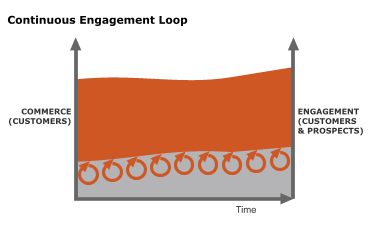Posts tagged ‘marketresearch socialnetworking socialnetworks cluetrai’
Continuous engagement… the death of market research
ESPN pulled the plug on their cell-phone product after investing $150m including $40m in advertising. This is precisely the failure market research is intended to prevent. How can business harness customers and prospective customers to improve their hit rate and time to market?
The following simple figures demonstrate the difference between traditional market research and continuous engagement.


There are dozens of differences between the two approaches. Research is ad-hoc or at regular intervals whereas continuous engagement is, well, continuous. Research is one-way, and engagement is two-way. Research is devoid of any direct brand benefit (and research purists will claim this is beneficial) whereas continuous engagement inculcates brand loyalty. Here’s a list of the primary differences:
- Research is ad hoc or regular interval; engagement is continuous
- Research is one-way (+ prize or payment!); engagement is two-way (mutually rewarding)
- Research is unemotional; engagement is emotional
- Research is independent of loyalty; engagement inculcates brand loyalty
- Research has a tight focus; engagement has a wide focus
- Research deals with sequential parameters; engagement is multi-parametric
- Research is designed to achieve statistical confidence; engagement is designed to detect weak signals.
The disadvantages of traditional market research
Ad hoc or regular intervals
- Your last data set getting on a bit?
- Trying to read between the lines because the last survey didn’t ask exactly the question you now need answering?
- Is your market speeding up relative to your research frequency?
- Do you need to ask new questions, but want to continue trending previous survey data?
One-way
- What’s in it for your respondents?
- Ever wondered if they’re answering your questions conscientiously?
- Are they likely to benefit or suffer as a consequence of the information they share with you?
Unemotional
- Quite simply, do they care?
Independent of loyalty
- Ad hoc, one-way, unemotional interaction does not drive brand loyalty.
Tight focus
- How long can you keep them interested for the remote chance of winning an iPod?
- Once you’ve collected the demographics, how long remains to get to the crux?
- By what degree can you change the subject?
- How many times can you change the subject before their brain starts hurting?
Confidence
After all that, it’s no wonder you need some mathematics to determine the statistical confidence.
Social media
The best way to understand your customers, is to have a relationship with them. Online. On the mobile. In store.
Social media is defined on Wikipedia as:
“the democratization of content and the understanding of the role people play in the process of not only reading and disseminating information, but also how they share and create content for others to participate. It is the shift from a broadcast mechanism to a many-to-many model, rooted in a conversational format between authors and people”.
More simply, we define social media in the context here as:
“all integrated channels through which you can get people discussing you and your market, with each other and with you”.
Wide focus
Anything and everything is discussed by your customers in social forums. For each topic, you can choose to interact or just listen.
You can also seed the forums with topics relevant to your business tomorrow, not just today. Test their reaction. Harvest value-added feedback; qualitative and quantitative.
Multi-parametric
Traditional research addresses a limited sequence of parameters, whereas social media can embrace multiple parameters.
Nevertheless, your product roadmap may encompass hundreds of parametric permutations. In this instance, you could chose to present ideas based on “runs” (parameter groupings based on Taguchi orthogonal arrays) to your most loyal and valued social media participants.
Detect weak signals
Weak signals are easily overlooked in traditional research. But understanding how to identify the most authoritative members in your social media, and learning to listen to them, can place you weeks if not months ahead of your competition in timely new product launches.
New skills
Supplanting or supplementing market research with continuous engagement requires:
- A new strategy
- An implementation framework
- New analyses methods
- Sound corporate performance measurement to close the loop
For and against
Unsurprisingly, there are advocates and detractors from this point of view. Take an interview with Bill Neal of SDR Consulting for example:
“..But I have some real problems with consumer generated media as a source of credible and reliable information. In many ways it combines the worst elements of non-scientific research – self selection and advocacy – both positive and negative.
The information they generate may be true, or not true – there is no way to discern which. Therefore, the information generated by those folks is neither credible nor reliable.”
However, this perspective could not be more strongly countered by the assertions made in the Cluetrain manifesto:
“A powerful global conversation has begun. Through the Internet, people are discovering and inventing new ways to share relevant knowledge with blinding speed. As a direct result, markets are getting smarter – and getting smarter faster than most companies.
These markets are conversations. Their members communicate in language that is natural, open, honest, direct, funny and often shocking. Whether explaining or complaining, joking or serious, the human voice is unmistakably genuine. It can’t be faked.”
OK, continuous engagement may not signal the death of traditional market research, but it marks a distinct and influential turning point; a turning point leading companies are adopting today for competitive advantage.
October 29, 2007 at 2:15 pm Philip Sheldrake Leave a comment